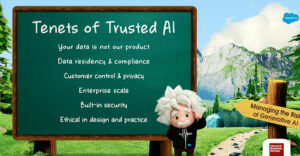I am seeing a pattern. Last time I looked at how Oracle’s generative AI is integrating into a variety of front- and back-office work areas like supply chain, HR, and, of course, CRM. Today, I want to examine Salesforce’s recently announced AI enhancements for its Field Service Suite.
The pattern that I see involves automating jobs.
In both cases, the vendors are adding automation that improves and possibly invents jobs. Now, no software that I am aware of is going to make a field service call that involves tools and component replacement, but the Salesforce suite aims at the next best thing.
Salesforce’s AI-Driven Innovation
In the process, Salesforce is doing a new job that field service people cannot do well enough, in some cases, because of their mobility. It’s hard to carry enough manuals in your truck, and trying to look up something on your phone is sometimes frustrating. That’s where AI comes in because it can be proactive in several ways.
First Data Cloud knows everything about customers and products, at least at the data level, meaning there’s a high probability a field service person can find an answer if a case is stumping them or, and this is important, find someone within the organization who can.
All of this behind-the-scenes research is a job in itself, and while field service people have usually been able to do that work alone, they may not have been able to achieve first-call resolution to a high degree. This continuation results in lower productivity and higher overhead for the organization if reps need to make return calls.
Diagnostics for Efficiency
Another way to achieve higher productivity is to enable better diagnostics. Salesforce achieves this in part through Visual Remote Assistant, which enables the field service tech to see a problem before arriving on the scene, thus getting a jump on the issue.
Finally, there’s Einstein Copilot for Mobile Workers, which can generate job summaries for customers. Technicians can use these summaries as the basis for reviewing the situation before and after, improving the customer experience.
All in all, this is a good example of how AI might be offloading some data-intensive parts of field service, but to me, it’s more because it does things for the worker and the customer that were not done as well earlier, if at all. Right there, you can see the evolution of a job that would never be given to a human simply because it would add unacceptable overhead. But the job needs doing, and automation is doing it.
A New Equilibrium
No workers are displaced in this scenario. Instead, it seems that technology is enabling people to work smarter while raising the quality of service and decreasing costs.
Too often, we lump automation together, and none of it is good for the worker. There are certainly automation efforts that eliminate humans from a process, and I think we’ll see AI doing its part. However, automation can also set a new equilibrium that enhances processes and customer experiences, and that’s what we are witnessing in many respects today using AI.

























































Social CRM
See all Social CRM